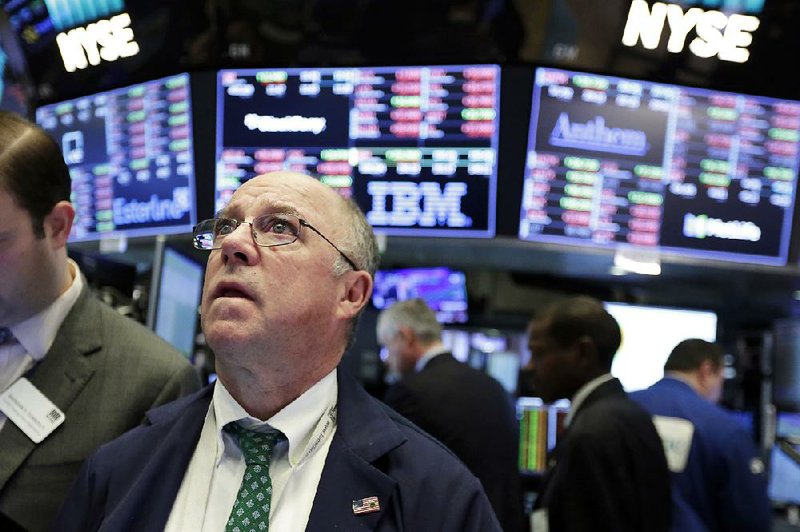U.S. stocks bounced up in the final hour of trading Tuesday after a rocky morning that saw the Dow Jones industrial average dip into correction territory.
After a big swing of more than 1,168 points during the day, the Dow landed up 2.3 percent, or 567 points, to finish at 24,914.
"Volatility is back," said Jamie Cox of Harris Financial Group. "It's not back in a big way, but it's not going to be dormant like it was in 2017. That's the real story."
While navigating volatile trading, money managers urged investors to keep calm and noted that the U.S. and global economies remain strong. On Tuesday, major companies reported another round of strong profits, with General Motors, BP, Allergan, health care companies and others beating analysts' expectations.
The Standard & Poor's 500 index, a broader market barometer that many index funds track, climbed 46.20 points, or 1.7 percent, to 2,965.14. The Nasdaq composite rose 148.36 points, or 2.1 percent, to 7,115.88. It was the busiest day of trading on the New York Stock Exchange since Nov. 10, 2016, two days after the presidential election.
Veteran traders and stock strategists say the slide in stock prices over the past week is a natural dip. The market had run up too high, too fast and needed to let off some steam, they say.
Federal Reserve Bank of St. Louis President James Bullard told reporters after a speech in Lexington, Ky., that "this is the most predicted sell-off of all time because the markets have been up so much and they have had so many days in a row without meaningful down days," Bloomberg News reported.
Bullard played down the risk of inflation, saying that data Friday showing a jump in average hourly earnings did not mean the economy was on the verge of a resurgence of inflation. He said other measures of wages were more restrained, Bloomberg reported.
Yet the markets remained nervous as exchanges in Asia and Europe plunged after Monday's record single-day point drop in the Dow -- it shed 1,175 -- renewing questions about whether the long-running stock rally is heading for a rout that might undercut President Donald Trump's frequent boasts claiming credit for the markets' rise.
"I think you've seen a normal market correction, although large," Treasury Secretary Steve Mnuchin said Tuesday at a House Financial Services Committee hearing. He said that computer-trading algorithms made the market drop on Monday worse. "It definitely had an impact on market moves," he said.
Nonetheless, Mnuchin said: "I'm not overly concerned about the market volatility. I think the fundamentals are quite strong."
Asked whether the administration would take responsibility for downturns as well as increases in the stock market, Mnuchin said, "We'll still claim credit that it's up over 30 percent since the election."
The yields on 10-year Treasury bills stood at 2.779 percent, below recent highs, and corporate bond rates held steady Monday, suggesting that a stampede out of stocks is not imminent.
The Dow briefly crossed into correction territory earlier in the day's trading, down more than 10 percent since its Jan. 26 high. The S&P 500 came close to the 10 percent correction threshold but did not cross into it.
Japan's Nikkei stock index closed down nearly 4.7 percent Tuesday, recovering from a 7 percent plunge earlier in the day. Hong Kong's Hang Seng index closed down 5.1 percent, and markets in Australia, South Korea and China also lost ground.
Minutes after the European markets opened, there were declines across most sectors. By the close of trading, the FTSE 100, which captures Britain's largest companies, had fallen 2.6 percent, Germany's DAX had tumbled 2.3 percent and France's CAC 40 had dropped 2.4 percent.
Amid the selling frenzy, traders were left trying to assess whether this was just a roller-coaster moment in an overall climbing market or possibly a pivot point that could end a historic upward run.
Investment adviser Edward Yardeni, author of the forthcoming book Predicting the Markets, said there have been 60 panics in the bull market that dates from March 9, 2009. Four of the panics knocked 10 percent to 20 percent off stock prices before the market recovered.
The latest sell-off is "Panic attack No. 60 rather than the beginning of a bear market," he said.
He added that "this time around, we have blue Friday followed by black Monday. While investors have suffered a black-and-blue bruising, we believe that the underlying strength in the global economy combined with the Trump tax cuts will boost earnings significantly this year."
Fidelity Investments on its website cautioned investors that timing the market is difficult and that missing a small number of sharply up days could hurt long-run returns on investment.
Analysts said the pace of the inevitable rise in interest rates remained a concern but that the swift plunge in the market midafternoon on Monday appeared to be linked to computer trading rather than fundamental economic problems. Others said that a correction in stock prices was overdue.
Pavel Molchanov, equity analyst at the firm Raymond James, said the sell-off resembled the computer-driven "flash crash" of 2010 or the sell-off after the referendum on Britain's exit from the European Union rather than a rerun of the financial crisis a decade ago.
"To state the obvious, on a percentage basis, yesterday's drop doesn't even enter the top 250," he said. "Also, the past week provides a reminder -- painful but timely -- that volatility has not been repealed. Nothing goes up in a straight line."
Information for this article was contributed by staff members of The Associated Press.
A Section on 02/07/2018

